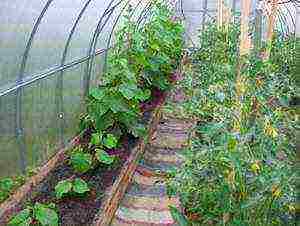Content
Usually broiler crosses are called breeds, so this term is also used in the article. Let's try to study in detail the existing broiler chicken breeds and determine which one is the best for growing. First, let's get acquainted with what breeds of chickens are used to obtain broilers?
Removal technology
To obtain broilers, breeders cross simultaneously two breeds of chickens with an exclusively meat bias: meat - white Cornish and meat-and-egg - white Plymouthrock. The hatched chickens are re-crossed with the white Cornish meat breed.
to content ↑ Pros and cons of content
Recently, in poultry farms and private farms, the variety of broiler chickens is leading - they are bred to obtain large volumes of meat in the shortest possible time. At 2 months, a chicken can weigh 2 kilograms or more. For such a result, a relatively small amount of feed is required - about 2-3 units per 1 kg of live weight.
back to content ↑ Benefits of chickens:
- the bird is rapidly gaining body weight;
- view undemanding in terms of nutrition and maintenance.
Estimated daily intake of dry feed for broilers of different ages
| Age, days | Amount of feed per day, gram |
| 1-15 | 15 |
| 6-10 | 20 |
| 11-20 | 45 |
| 21-30 | 65 |
| 31-40 | 85 |
| 41-50 | 100 |
| 51-60 | 115 |
to the content ↑ The disadvantages of the breed are as follows:
- the adults lay few eggs. As a result, the predominance of meat breeds in their breeding;
- it is impossible to breed full-fledged broiler chickens on their own. Since even if the hen will lay eggs, the chickens obtained from them will be significantly inferior in growth rates and in terms of meat indicators to their parents.
It is necessary to be especially careful when choosing a varied and high-calorie poultry feed. Broiler chicks eat more than other chicks. This is due to their genetic disposition to gain weight quickly.
back to contents ↑ Broiler varieties
Breeders try to choose the most resistant and healthy individuals in order to breed highly productive crosses. The newest breeds are discovered annually, and the previously developed ones are rapidly forgotten.
This is explained by the fact that the “freshest” sectioned crosses of broiler chickens are more advantageous than their predecessors by all criteria. Let's consider in detail the characteristics of each cross.
back to contents ↑ KOBB-500 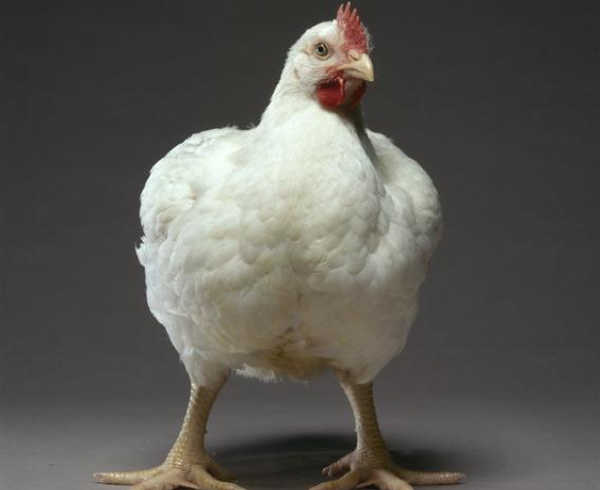
Broiler KOBB-500
The difference between these broiler chickens is the bright yellow tint of the skin. It is the yellow chicken meat that is in demand on the market, and therefore KOOB is in demand. Cross has the following characteristics:
- increased resistance to viruses and diseases, almost 100% survival rate;
- chickens are distinguished by powerful lower limbs and a wide brisket.
At the age of 6 weeks, chick carcasses are already suitable for slaughter. At this stage, the weight of the bird varies between 2-2.5 kilograms.
Back to contents ↑ ROSS-308 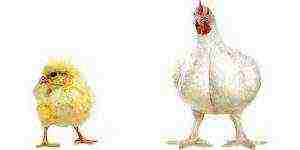
ROSS-308
Representatives of this species grow very quickly. The daily weight gain of the chick is 50-60 grams on average.
Characteristics:
- relatively good egg production;
- these chickens have pale meat;
- significantly fleshy and wider chest part of the carcass.
The most active period of chick growth is the first weeks after hatching.
Back to contents ↑ ROSS-708
This is the "youngest" of the bred broiler crosses. Due to its unique early maturity, it is the leader among other broilers.Within 1 month, the chicken reaches an impressive size, and its weight is 2.5 kilograms. The skin tone of these broiler chickens is similar to that of COBBs. The carcass of ROSS chickens usually simply does not have time to acquire the necessary yellowness.
back to contents ↑ Broiler 61
The breed is characterized by an intensive rate of weight gain along with low feed costs:
- offspring of chickens are characterized by a high survival rate;
- this bird is characterized by good egg production;
- fast growth rates of chickens - another feature of the cross;
- meat has unique taste.
The live weight of chickens at 1.5 months is on average 1.8 kilograms.
Back to contents ↑ Gibro-6
To obtain this species, two Cornish and White Plymouth Rock were used. As a result:
- egg production of chickens is low - about 160 pieces in 40 days;
- poultry skin and subcutaneous fat are yellowish;
- this type of broiler chickens is distinguished by a calm disposition.
One chicken at 1.5 months has a carcass weight of 1.5 kg. The chick on average gains a daily weight of about 30-80 grams.
back to contents ↑ Cross Change 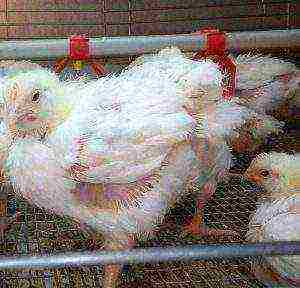
3 week old chick
Breeders working at the Smena pedigree breeding plant bred broiler chickens of this species, from where the name came from:
- poultry meat is characterized by high-quality taste indicators;
- the vitality of young animals reaches 97%.
The resulting hybrid stands out for its intensive growth and daily weight gain of up to 50 g.
back to contents ↑ Broiler-M
Broiler chickens of the broiler-M breed appeared in the process of cross-crossing of mini-chickens and cockerels of other breeds:
- the body is compact in size with short legs;
- when keeping broiler chickens of this cross, there is no need to use large areas;
- rather large eggs (60-65 grams), despite the small dimensions of broiler chickens.
At 2 months, the weight of the female varies in the region of 1.5-1.8 kilograms. The weight of an adult rooster is about 3 kg, of a chicken - 2.5 kg.
back to contents ↑ Cross Hubbard F 15 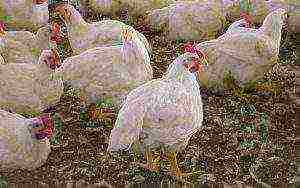
Cross Hubbard
These representatives are distinguished by a high level of early maturity in relation to small expenditures on feed:
- birds are quite profitable to keep for outdoor breeding;
- due to the small size of the individual, you can get a large livestock.
A characteristic feature of broiler chickens of this breed is excellent survival.
Having studied the photos and the above facts, it becomes clear that growing broilers is a profitable business. This is an opportunity to get large amounts of dietary chicken meat in the shortest possible time and with minimal feed costs. If you approach and care for poultry correctly, broilers will delight you with fast growth rates and rapid weight gain.
to the content ↑ What breed is better to grow?
Given that the world's population is growing every year, the need for food is also increasing. Scientists and breeders are trying to develop broiler species that can provide meat to the maximum number of consumers while minimizing costs.
This leads to the emergence of new breeds of broiler chickens. And outdated crosses are receding into the shadows, giving way to more modern, modified and highly productive breeds.
Let's try to figure out in detail what breeds of chickens are more profitable to choose among broilers? To do this, consider a detailed description of the most highly effective representatives of the broiler chicken breed.
back to content ↑ Broilers of breed KOBB-500
This species is characterized by such distinctive qualities as white plumage and yellow skin due to genetic characteristics. Even when unpigmented food is used in the diet, the tint of the skin of each individual will still be yellow.
These representatives can be safely identified with the most highly efficient growth productivity and the shortest feeding period, in comparison with other crosses. On average, the weight of a carcass at the age of 35 days is 1.9 kilograms, and at 42 - 2.4 kilograms.It is this cross that is considered to be the most effective type of broiler around the world.
Cross-country advantages:
- fast pace of weight gain;
- flock uniformity is represented by the highest percentage;
- meat production is the most inexpensive;
- the best ratio of consumed feed to products received;
- large, massive legs and a fleshy breast;
- the main advantage is that the survival rate of the bird is 94-98%.
The above features in the complex give KOBB-500 an advantageous position: in a competitive ratio, the lowest price per 1 kilogram of live weight of a bird.
to the content ↑ Broilers of breed ROSS 308
This type of chick is suitable for breeders looking for a bird with versatile qualities. Chickens of this cross are characterized by high egg production and hatchability of chicks. This enables them to compete in the broiler chicken market.
Cross-country advantages:
- early maturity and rapid growth rate of poultry;
- individuals are undersized;
- muscle mass is well developed;
- pale skin color;
- the level of performance is sustainable.
Both broiler breeds are profitable in terms of rearing. It all depends on your wishes and preferences. When the consumer needs a broiler with a wide breast, and the color of the carcass is not important, then it is necessary to grow the POCC 308 breed. Distinctive features of this representative can be called low growth, the color of the fluff of the chickens is bright yellow, the color of the carcass after slaughter is white.
And vice versa, those interested in the yellow tint of the carcass should choose KOBB-500 chickens. Since only this species has a genetic predisposition to a yellow skin tone. The down of young animals has black blotches. Feet are usually yellowish in color (may be white), but massive.
Choose for yourself which of these wonderful breeds will satisfy your needs as much as possible. Based on the information in the article, first decide what qualities of the bird you are interested in. Happy choice!
← Previous articleThermostat for an incubator: device, principle of operation, how to do it yourself Next article → Chinese silky breed of chickens
Broiler chicken breeds are highly prized in households and farms. All modern broiler breeds are crosses obtained from crossing the best meat and egg chickens. In order not to be mistaken with the choice of the broiler chicken breed, we offer a description of the 8 most productive crosses that can be grown for meat.
Features of broilers
Broilers are distinguished from ordinary chickens by their large size and intense muscle gain due to genetics. If a regular chicken at the age of 2 weeks weighs no more than 0.5 kg, then a broiler chicken by this time can weigh more than 1 kg. Adults (5–6 months) reach a weight of 4–4.5 kg, and sometimes more than 5 kg.
The broiler has a compact body, small wings in relation to the carcass and short legs. The color of the plumage is predominantly white, although there is also an ash-black-white tricolor. These are phlegmatic and sedentary birds that prefer high-calorie feed. With proper fattening, their meat becomes tasty and nutritious in 2-3 months, so there is no point in keeping chickens any longer. With proper fattening, a broiler chicken gains about 2 kg in a couple of months and is actually ready for slaughter. Of course, not all crosses have such a growth rate. Broilers are raised to adulthood only to produce eggs and offspring.
Their productivity depends on what breeds of chickens are crossed to obtain broilers. Since the main goal in breeding crosses is to obtain meat, the egg production of these birds is low, but the hen's instinct is well developed. Of the shortcomings, one can only note the fact that broilers are not able to inherit their positive qualities, so their offspring are often weak, and crossing with each other is not practiced.
Best breeds
Every year, new highly productive crosses appear, so it is rather difficult to decide which breeds of meat broilers are best to grow. Below is a description and requirements for the maintenance of several breeds that have retained popularity over the past years.
ROSS-308
This breed belongs to the English selection. It is an ideal choice for small farms as it combines good egg production (over 180 eggs / year) with high meat performance. The daily weight gain of young animals is 55–60 g, and the chickens reach 2.5 kg at the age of 2 months. Birds are unpretentious and capable of breeding quite viable offspring, which happens infrequently in broilers.
Not all consumers like the light skin color of carcasses, but this does not affect the taste in any way.
COBB-500
Broilers of this breed are distinguished by their large carcass sizes and a beautiful yellow skin tone, which is especially popular with consumers. The cross is characterized by early maturity and a rapid increase in live weight - at the age of 1.5 months, young animals weigh 2.5 kg and are ready for slaughter. It is also worth noting the high survival rate of chickens - 97%. However, the productivity of chickens is highly dependent on the conditions of keeping, diet and quality of feed.
ROSS-708
If you are interested in what breed of broilers is the best for obtaining and selling meat products, then this is undoubtedly ROSS-708. Provided the correct maintenance (diet, light and temperature conditions), young animals reach a weight of 3 kg in just 35 days. Carcasses of chickens are round, with a wide breast and short powerful legs, but the skin, again, is white. Chickens are easily adaptable and get along with other birds, which made this breed the most popular among broilers.
Broiler 61
A positive feature of this cross is a high coefficient of live weight gain with low feed costs. To build up 1 kg of meat, a chicken needs only 2 kg of feed, and with such a diet, it reaches a mass of 2 kg by the age of 1.5 months. Birds are undemanding to keeping, and the survival rate of young animals is 98%. However, due to the intensive growth, the chickens remain weak for a long time, and if you need to raise them to adulthood, you will have to tinker.
The egg production of chickens is average (140–150 eggs), but the meat is of high quality and unique taste.
Hybro-6
This is a multi-line hybrid, for which it was necessary to cross two types of chickens on the paternal and maternal lines. Cross does not differ in intensive growth (daily weight gain is 30 g) and large size - a six-month-old rooster weighs only about 1.6 kg, and a chicken is even less (up to 1.3 kg). However, the carcass of these broilers looks very attractive: the yellow skin and the large amount of subcutaneous fat put it on a par with the homemade product.
Cross Change
This is a domestic hybrid bred at the Smena breeding plant of the same name. According to its productive characteristics, it is considered universal - it combines good weight gain (up to 50 g / day), stable reproduction and good egg production (140–150 eggs per year). Unlike foreign crosses, these birds are perfectly adapted to domestic conditions. Chicks are 97% viable but require 2-3 ° C higher temperatures in the early days than other broilers.
Broiler-M
If we compare this cross with other meat hybrids, then we can say that these are poultry of the meat and egg direction. They have small muscle mass and compact build (adults weigh about 3 kg), but good reproduction and egg production. From one chicken per year, you can get about 160 eggs weighing 65–70 g. Chickens are unpretentious, they feel comfortable in cages, which allows them to be kept in factories and farms.
Cross Hubbart F 15
Choosing the best breeds of broiler chickens for home breeding, one cannot fail to note the cross of the French selection Hubbard F 15.It is characterized by high early maturity at low feed costs. Young animals are slaughtered at the age of 1–1.5 months, upon reaching a weight of 2.5 kg, since then the growth of birds slows down. This, of course, is not the most unpretentious cross. Its productivity depends on the quality of feed, keeping conditions (temperature, humidity, hygiene, density per 1 m²), and even climate, but the excellent taste of these chickens is worth it.
Video "Growing broilers"
This video will show you how to raise broilers at home.
To obtain a large amount of chicken meat in a short period, it is required to start productive birds from the position of growth. For this reason, broilers have become very popular on farms and small farms. At the moment, there are several types of chickens that are the main ones. In this review, it is about them that will be discussed.
Bird overview
Many people think that broilers are a separate breed of chicken. However, in reality this is not the case. This name should be understood as birds that are grown in order to get meat in large quantities. Chickens for slaughter should be sent after reaching the age of 1.5 to 3 months. At the same time, meat can be obtained several times more than from ordinary chickens.
The emergence of birds
For the first time, broilers were bred by English farmers who tried to cross different breeds of chickens. At first, chickens were considered gigantic, larger in comparison with other birds. However, it later became clear that the bred chickens reproduce extremely poorly. After a generation, you could get regular chickens.
Later, it was possible to figure out that chickens can be purchased in a hybrid way, by crossing different types of meat birds. Broilers were bred on special farms. Over the years, breeders have managed to breed different crosses that combine different qualities. The bred birds could mature quickly enough and gain a lot of weight. In addition, they were highly immune.
External features
Broilers are larger than other chickens. Regular chickens, having reached the age of 1.5 weeks, gain half a kilogram of weight. Indicators of crosses at this age reaches 1.5 kilograms. Adults can gain up to 5.5 kilograms.
Broilers are distinguished by their compact build, short legs and wings. Chickens are characterized by low activity, phlegmatic character. Broilers of white color are quite common.
Productive qualities
Broiler breeds can gain weight quite quickly. At two months of age, chickens weigh up to 2 kilograms. In order for the animal to gain weight, a lot of food is not required. Broilers are genetically positioned for this. But they still eat more than regular chickens. For this reason, the diet should be based on a high-calorie feed.
Such a parameter as egg production does not have a high level. It is rather poorly developed. However, broilers can make great hens. If it was decided to start raising chickens on their own, you will need to create all the necessary conditions for active reproduction.
The largest birds
In order to obtain highly productive hybrids, breeders try to choose only healthy, resistant individuals. With each new year, there are more crosses. Previous specimens become obsolete rather quickly. The latter breeds have more advanced characteristics. You should consider the types of pets that are the largest.
COBB-500
A distinctive characteristic of this breed is the bright yellow hue present in the skin. On the market, meat with a yellowish tone, rather than pale, has become widespread. For this reason, representatives of this breed have become very popular. Chicks ripen quickly enough. After 6 months, the bird can be sent for slaughter.During this period, body weight reaches 2.5 kilograms.
This breed is distinguished by high immunity and survival rate. Birds are characterized by large paws, broad chest.
ROSS-708
At the present stage, representatives of this variety are in leading positions. This is largely due to early maturity. Within a month, the chicken will gain 2.5 kilograms. In terms of skin color, chickens resemble COBBs. However, sometimes the meat does not have time to get a yellowish tint.
This species of birds will be discussed in more detail in the video.
ROSS-308
Broilers of the ROSS-308 breed differ in that they grow quite quickly. Chickens have a weight gain of 50-60 grams per day. The most active growth rate occurs in the first weeks. Poultry meat has a pale shade. The chicken breast is wider and fleshy than the variety described above.
As the description says, chickens differ in good egg production. Therefore, representatives of this breed can be used in the household, not only for obtaining meat.
Broiler-61
Representatives of this breed were obtained by crossing such types of chickens as Cornish and Plymouthrock. The crosses have managed to acquire their best characteristics. Birds have a fairly high rate of weight gain. However, they do not need a lot of feed.
At 1.5 months of age, weight indicators reach 1.8 kilograms. Such an indicator is not considered a record, but it is quite high. In addition, chickens of this breed are distinguished by good performance and a high level of chick survival.
Based on the above, it can be noted that raising meat birds can be beneficial. At the same time, the costs will not be too high. As a result, you will be able to get good chicken meat in large quantities. However, it should be understood that it is necessary to provide the animal with proper care. Otherwise, pets will not be able to develop at a rapid pace, gain weight.
Photo gallery
Video "Growing broilers"
How to raise meat pets? The main nuances of this process will be discussed in detail in the video.
Loading …


